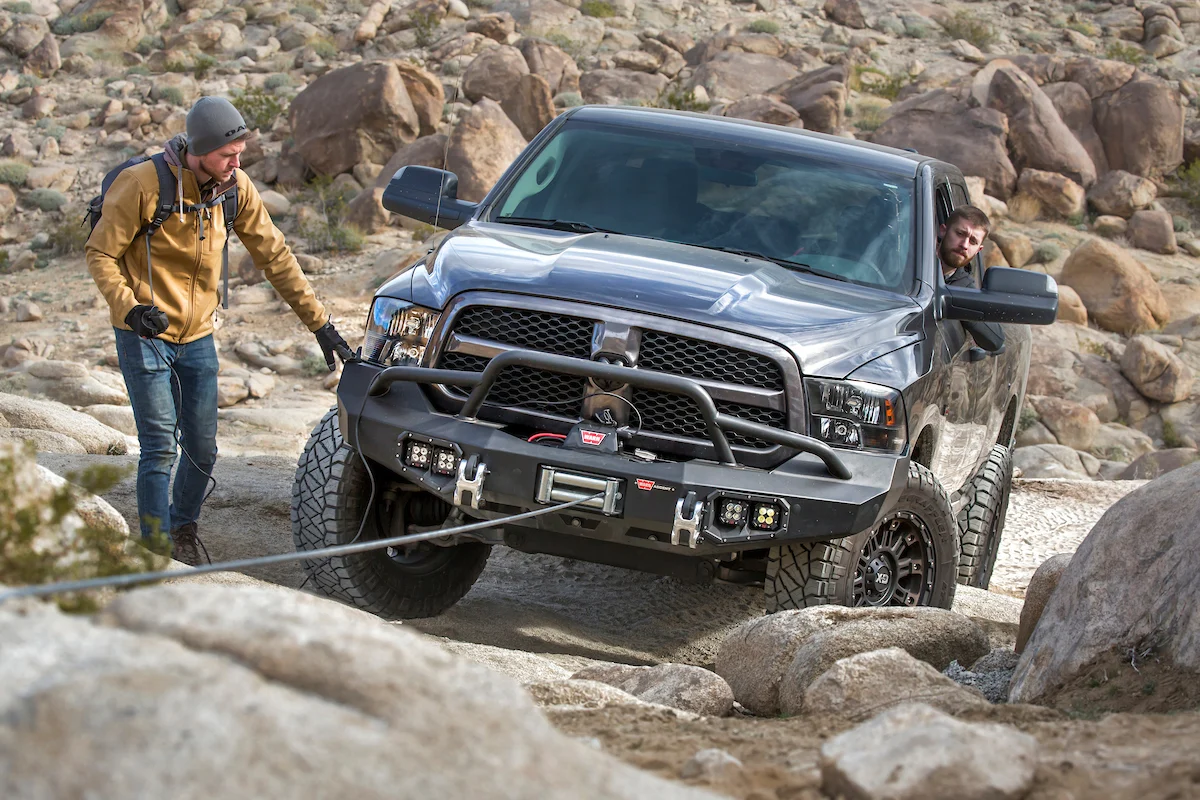Picking the right battery to power your winch

Getting out of a tough situation with a winch requires the right battery for your four-wheel-drive vehicle.
There are so many battery specifications, features, and benefits to sift through that choosing a battery can become overwhelming. Here are some tips to make sure you’re prepared to be up and back off the beaten path in a pinch:
The basics - What’s required:
You will need enough Cold Cranking Amps (CCA) in the battery to power both your engine and winch. The battery must have the reserve capacity to supply enough power to the winch. A 12-volt battery rated up to 650 CCA will typically be enough for a 12,000 lb. vehicle which is the general standard for winches.
However, always consult with your winch manual to check the recommended battery rating and size as requirements can vary.
When installing the battery, look if it is installed upright or sideways. If it’s sideways, a flooded battery will not work as it will leak out its electrolyte fluid and no longer function. This means an AGM battery is required.
What’s recommended:
The higher the CCA rating, the more reserve capacity it will have and leaves less chance of getting stranded in the middle of nowhere. Because of the high-stress conditions of activities such as off-roading and other recreational uses, getting a battery that can handle high amounts of vibration will also extend the total life of the battery.
Flooded batteries constructed with element and anchor bonding will have increased durability and service life for high-vibration environments due to battery plates being bonded together at the top and bottom of the plates themselves.
A winch will work if your vehicle engine is off but will only operate for a few minutes. You’ll likely need more time than that and is the reason why it’s recommended to run your vehicle engine while winching. Also, connecting a stand-alone winch battery to the battery in your vehicle with a properly sized trailer wiring kit ensures there’s more than enough power to operate the winch and start your vehicle.
Choosing the right type of battery suitable for winching:
Flooded: The most common type of vehicle battery. They come in all shapes and sizes for use in many applications. A sealed flooded battery will be your only option for off-roading or similar use to ensure the battery does not spill their electrolyte while the vehicle is in operation.
- Benefits:
- Comparatively, these are inexpensive and easy to troubleshoot batteries suited for many needs.
- Tried and true, they are extremely reliable with a long and deep discharge cycle life.
- Charge perfectly with the OEM alternator.
- Negatives:
- They need to be installed upright and weigh more than their counterparts.
- They are not the best choice for off-road rock crawling applications where the vehicle is not upright.
Starting Absorbed Glass Mat (AGM): Spill-proof and self-contained, AGM batteries take the traditional flooded lead acid battery to the next level.
- Benefits:
- AGM battery plates are sandwiched between glass mats which drastically improves charging time, have a longer overall life, and do not require any additional maintenance.
- Can be installed on odd angles for vehicles that require it.
- Constructed to withstand high amounts of vibration.
- Negatives:
- These will cost more than traditional flooded batteries.
- Some older battery testers will not work.
- Require a higher alternator output to fully charge.
Deep-Cycle AGM: Designed to run a marathon and not a sprint, these are ideal if you can have a stand-alone battery solely to operate a winch.
- Benefits:
- Deep-cycle AGM battery plates are sandwiched between glass mats which drastically improves charging time, have a longer overall life, and do not require any additional maintenance.
- Have a deeper depth of discharge that a standard AGM battery.
- Can be installed on odd angles for vehicles that require it.
- Constructed to withstand high amounts of vibration.
- Negatives:
- These will cost more than traditional flooded batteries.
- Not designed for vehicle starting.
- Requires additional hardware to connect to the starting battery.
- Adding additional batteries adds weight and takes up more space under the hood.
Lithium Batteries: We strongly recommend not using lithium batteries for winching applications unless installed by a qualified installer. Lithium batteries for winching require additional circuit protection devices to protect the winch and battery.

Getting the best performance for your hard-earned dollars:
When buying a single battery to reliably support serious winching activity and engine cranking, a true deep-cycle battery with a high reserve capacity with enough high rate cranking current to turn the engine over is recommended.
Batteries designed for cranking – even with a high reserve capacity – are not designed to be deeply discharged. Deeply discharging a battery primarily designed for engine cranking will shorten its life.
Consider the type of weather you expect to experience. Engines require batteries with higher cranking power in colder temperatures. If the winch is installed and will be rarely used, the best bang for your buck is to invest in a starting battery with the most CCA available.
High CCA starting batteries typically also have high minutes of reserve capacity ratings. The reserve capacity (MRC) measures the amount of time the battery can power the winch.
Other factors to consider include:
- Maintenance: AGM batteries require much less maintenance and can be installed in any position.
- Size and weight: Ensure the battery fits where it is installed.
- Warranty: Considering the heavy usage these batteries will have, pick a manufacturer that offers a multi-year warranty.
- Remember: Always recycle your old batteries at an authorized recycling location. You may even get paid for returning it.
Check out Canadian Energy’s extensive selection batteries: https://www.cdnrg.com/batteries
Or come into your nearest branch to ask what works best for you and your vehicle: https://www.cdnrg.com/locations/branches
